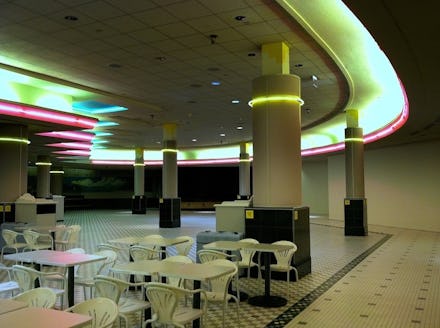What These Haunting Viral Images of an Abandoned Food Court Really Mean for America

Sbarro, American food court staple and maker of the greasiest meat lover's calzone known to man, is suffering from economic indigestion. The company filed for bankruptcy in 2011, and on last Thursday it closed 155 stores across the country — 16% of its American locations. The restaurant's spokesman, Jon Dedmon, said that most of the shuttered stands were located in dying mall food courts.
Just a couple weeks before, a blogger's haunting photographs of an abandoned food court in what was once Maryland's White Flint Mall went mega-viral. Everybody thought they were beautiful, but they were telling a deeper story that nobody heard: It turns out that our food courts have been disappearing — and there's good reason to miss them.
Image Credit: Duck Pie
James W. Rouse dreamt up the first food court in the 1970s in order to bolster economic growth. He envisioned the courts as creating strong, healthy and even patriotic communities where people of all classes could mingle. The idea caught, and, for more than 30 years after, these mini utopias full of McDonald's, Mrs. Fields and that local Smoothie franchise you were never brave enough to try reigned supreme in the American culinary landscape.
Image Credit: Duck Pie
But then the online shopping boom in 2007 and the recession began to usher them out, leaving mall vacancies at an all-time high. Mall developers needed a way to redirect affluent shoppers from their Amazon shopping carts back to the concrete mall. They thought the solution lay with the only thing that can't be recreated online: mall food. But shoppers had grown wary of the tired food court model, which had a reputation of being riddled with unhealthy food, germs, loud loiterers and even health violations and crime. Management lured these jaded customers back by overhauling the old concept of the food court and updating it to accommodate the post-recession habits and expectations of the upper-middle class.
Image Credit: Duck Pie
Shopping mall developers replaced many food courts with aesthetically modern, "upscale" dining experiences. Whereas food courts once were known for their Taco Bells, now they're the domain of the $12 panini sandwiche. America is knee-deep in the celebrity chef movement, as well as the "fast-casual," organic and local movements, where quality takes precedence over affordability, and brand is emphasized over quality. Household names like Anthony Bourdain and Mario Batali worked with retail groups to build upscale food court/grocery store hybrids called "food halls," across the country. And slowly the food court faded, consigned to airports and the dingy basements of corporate buildings.
Image Credit: Duck Pie
Unfortunately, it's clear that whoever manages the new eateries in shopping malls only has the top income bracket in mind. Lunch at these new and improved food courts often costs a day's worth of minimum wages. The only people who spend $13 per week, let alone per meal, on mall fast food, make more than $100,000 a year, according to the latest data from the International Council of Shopping Centers. If lunch at a new, more upscale food court costs a minimum of $10, it's clear that developers of the "new food court" don't care much about those with incomes less than 100 grand a year. They are excluding the entire demographic that food courts were meant to bring together.
Image Credit: Duck Pie
It's true that food courts in more transient environments may not help people of different races and classes become friends forever. That's what Mario Small, Dean of Social Sciences at the University of Chicago believes. But a vision of eclectic groups of people grabbing pizza at Sbarro and then fries at Arby's, clumped at back-to-back tables, all dumping their trash in one repository is still an iconic memory in the memory of many Americans. And as we trade Burger Kings for eating like kings, we are demolishing a piece of American history — a democratic dream of the kind fast fading from public life.